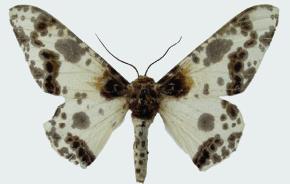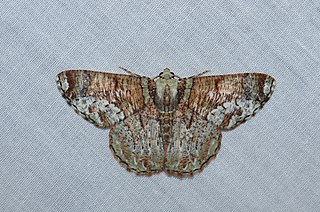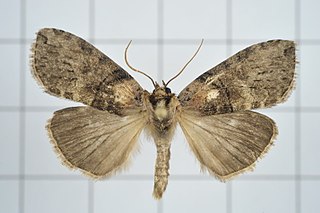
Adenophora is a genus of flowering plants in the family Campanulaceae, the bellflowers. Plants of this genus are known commonly as ladybells. Most are native to eastern Asia, with a few in Europe. Many are endemic to either China or Siberia.

The peach blossom is a moth of the family Drepanidae. It was first described by Carl Linnaeus in his 1758 10th edition of Systema Naturae.

Triadica is a plant genus of the family Euphorbiaceae first described as a genus in 1790. It is native to eastern southeastern, and southern Asia.
- Triadica cochinchinensisLour. - China, Cambodia, Assam, Bangladesh, Bhutan, Nepal, Himalayas of E + N India, Borneo, Sulawesi, Sumatra, Laos, Malaysia, Myanmar, Philippines, Thailand, Vietnam
- Triadica rotundifolia(Hemsl.) Esser - Guangdong
- Triadica sebifera(L.) Small - China, Japan; naturalized in Himalayas, Cuba, Puerto Rico, SE + SC USA, Sacramento Valley in N California

Linnaea is a plant genus in the honeysuckle family Caprifoliaceae. Until 2013, the genus included a single species, Linnaea borealis. In 2013, on the basis of molecular phylogenetic evidence, the genus was expanded to include species formerly placed in Abelia, Diabelia, Dipelta, Kolkwitzia and Vesalea. However, this is rejected by the majority of subsequent scientific literature and flora.

Biston regalis is a moth of the family Geometridae. It is found in China, Taiwan, Russia, Japan, North Korea, South Korea, India, Nepal, the Philippines, Pakistan and the United States.

Biston panterinaria is a moth of the family Geometridae. It is found in China, India, Nepal, Sikkim, Vietnam and Thailand.

Miltochrista aberrans is a moth in the family Erebidae first described by Arthur Gardiner Butler in 1877. It is found in China, Korea, Russia, Japan and Taiwan.

Lophophelma erionoma is a moth of the family Geometridae first described by Charles Swinhoe in 1893. It is found in the Chinese provinces of Hunan, Guangxi, Zhejiang, Fujian, Jiangxi, Hainan and Sichuan, and in the north-eastern Himalayas and Sundaland. The habitat consists of lower montane and upper montane forests.
Pachyodes amplificata is a moth of the family Geometridae first described by Francis Walker in 1862. It is found in China.

Pingasa alba is a moth of the family Geometridae first described by Charles Swinhoe in 1891. It is found in the Chinese provinces of Hubei, Hunan, Guangxi, Zhejiang, Yunnan, Fujian, Guizhou, Jiangxi and Sichuan, and in Taiwan and Japan.

The history of the administrative divisions of China is covered in the following articles:
Eupoecilia amphimnesta is a species of moth of the family Tortricidae. It is found in China, Taiwan, India, Japan, Korea, Mongolia, Russia and Europe.

Spilarctia subcarnea is a moth in the family Erebidae. It was described by Francis Walker in 1855. It is found in Nepal, China, the Russian Far East, Korea, Japan and Taiwan.

Mosla is a genus of plants in the family Lamiaceae, first described as a genus in 1875. It is native to eastern Asia, the Himalayas, and southeastern Asia.
- Mosla bracteataDoan ex Suddee & A.J.Paton - Vietnam
- Mosla cavalerieiH.Lév.- Vietnam, Guangdong, Guangxi, Guizhou, Hubei, Jiangxi, Sichuan, Yunnan, Zhejiang
- Mosla chinensisMaxim. - Vietnam, Korea, Japan, Anhui, Fujian, Guangdong, Guangxi, Guizhou, Hubei, Hunan, Jiangsu, Jiangxi, Shandong, Sichuan, Taiwan, Zhejiang
- Mosla coreanaH.Lév. - Korea
- Mosla dianthera(Buch.-Ham. ex Roxb.) Maxim. - China, Japan, Korea, Ryukyu Islands, Kuril Islands, Primorye, Caucasus, Himalayas, Myanmar, Vietnam, Philippines, Sumatra
- Mosla exfoliata(C.Y.Wu) C.Y.Wu & H.W.Li - Sichuan
- Mosla hangchouensisMatsuda - Zhejiang
- Mosla japonica(Benth. ex Oliv.) Maxim. - Japan, Korea, Ryukyu Islands
- Mosla longibracteata(C.Y.Wu & S.J.Hsuan) C.Y.Wu & H.W.Li - Guangxi, Zhejiang
- Mosla longispica(C.Y.Wu) C.Y.Wu & H.W.Li - Jiangxi
- Mosla pauciflora(C.Y.Wu) C.Y.Wu & H.W.Li - Guizhou, Hubei, Sichuan
- Mosla punctulataNakai - Korea, Taiwan, Japan, China
- Mosla scabra(Thunb.) C.Y.Wu & H.W.Li - Vietnam, Korea, Japan, Ryukyu Islands, Anhui, Fujian, Gansu, Guangdong, Guangxi, Henan, Hubei, Hunan, Jiangsu, Jiangxi, Liaoning, Shaanxi, Sichuan, Taiwan, Zhejiang
- Mosla soochouensisMatsuda - Anhui, Jiangsu, Jiangxi, Zhejiang
- Mosla tamdaoensisPhuong - Vietnam
Scoparia congestalis is a moth in the family Crambidae. It was described by Francis Walker in 1859. It is found in Japan, Sri Lanka, Taiwan, Korea, Pakistan, Russia and China.

Horipsestis aenea is a moth in the family Drepanidae. It was described by Wileman in 1911. It is found in Taiwan, the Chinese provinces of Henan, Shaanxi, Gansu, Hubei, Jiangxi, Hunan, Fujian, Guangxi, Hainan, Sichuan and Yunnan and in Vietnam.











